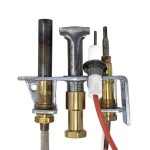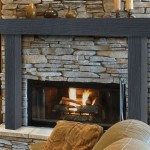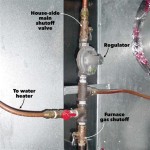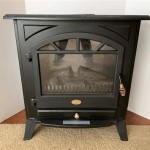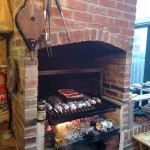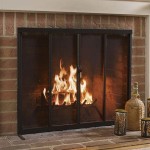Painted Cobblestone Fireplace: A Transformation Guide
The cobblestone fireplace, a feature often associated with rustic charm and timeless appeal, can sometimes appear dated or clash with evolving interior design preferences. A painted cobblestone fireplace presents a viable option for updating the aesthetic without undergoing a costly and disruptive removal process. This article explores the considerations, preparation steps, painting techniques, and finishing touches involved in successfully painting a cobblestone fireplace, enabling homeowners to achieve a refreshed and modernized focal point.
The decision to paint a cobblestone fireplace should be approached with careful consideration. Factors such as the existing color palette of the room, the desired style of the fireplace, and the overall aesthetic goals for the space should be assessed. Painting cobblestone is a permanent alteration, and while it is possible to reverse the process, it is a labor-intensive undertaking. Therefore, exploring alternative options, such as limewashing or simply updating the surrounding décor, may be worthwhile before committing to a full paint job. Digital rendering or the use of photo editing software to visualize the finished product can also aid in the decision-making process.
Assessing the Cobblestone and Choosing the Right Paint
The type of cobblestone used in the fireplace construction significantly impacts the painting process and the paint selection. Different types of stone possess varying levels of porosity, texture, and chemical composition. This variation can influence the paint’s adhesion, absorption rate, and overall durability. Prior to commencing any painting, a thorough inspection of the cobblestone is crucial. Any loose or crumbling mortar should be repaired, and efflorescence (a salty, white deposit that can appear over time) should be addressed.
Paint selection is paramount for achieving a long-lasting and visually appealing result. Latex-based paints are generally preferred for indoor stone surfaces due to their breathability and ease of application. However, for fireplaces, heat-resistant paints specifically designed for masonry are essential. These paints are formulated to withstand the high temperatures generated by the fireplace without cracking, peeling, or releasing harmful fumes. Furthermore, consider the desired finish. Matte finishes tend to conceal imperfections and offer a more natural look, while semi-gloss or gloss finishes provide greater durability and are easier to clean, but they can also highlight the texture of the cobblestone more prominently.
Primer plays a vital role in ensuring proper paint adhesion and preventing the cobblestone from absorbing excessive amounts of paint. A masonry primer is specifically formulated to penetrate porous surfaces and create a stable base for the topcoat. The primer should be applied evenly and allowed to dry completely before proceeding with the paint application. Tinting the primer to a similar color as the chosen paint can also enhance the final outcome by minimizing the number of coats required to achieve full coverage.
Preparation: Cleaning, Repairing, and Protecting the Area
Preparing the cobblestone surface is a critical step that directly influences the final result. Thorough cleaning is essential to remove dirt, dust, soot, and any existing coatings that could impede paint adhesion. This process typically involves using a stiff-bristled brush, a mild detergent solution, and plenty of water. For stubborn stains or efflorescence, a specialized masonry cleaner may be required. After cleaning, the cobblestone must be allowed to dry completely, typically for at least 24 hours, to ensure optimal paint adhesion.
Repairing any cracks, chips, or loose mortar joints is equally important. Failing to address these issues before painting can lead to uneven paint application, increased moisture penetration, and potential structural damage. Employ a pre-mixed masonry repair compound to fill any imperfections and smooth the surface. Allow the repair compound to cure completely according to the manufacturer's instructions before proceeding with priming and painting.
Protecting the surrounding area is crucial to prevent unwanted paint splatters and drips. Drop cloths should be placed over the flooring and furniture near the fireplace. Painter's tape should be used to mask off any adjacent surfaces, such as the wall, mantel, or hearth. Consider using plastic sheeting to cover any delicate items that cannot be easily moved. Adequate ventilation is also essential, as some paints and primers can release fumes. Open windows and doors to ensure proper airflow during the painting process.
Painting Techniques and Achieving Desired Effects
When painting a cobblestone fireplace, various techniques can be employed to achieve different visual effects. A standard approach involves using a brush and roller to apply the paint evenly. A brush is ideal for reaching into the crevices and indentations of the cobblestone, while a roller can be used to cover the larger, flatter surfaces more efficiently. Multiple thin coats of paint are preferable to a single thick coat, as they reduce the risk of drips, runs, and uneven coverage. Each coat should be allowed to dry completely before applying the next.
Dry brushing is a technique that involves applying a small amount of paint to a dry brush and then lightly brushing it over the surface of the cobblestone. This technique creates a textured, weathered look and can be used to highlight the natural variations in the stone. To achieve a dry-brushed effect, dip the brush into the paint, then wipe off most of the paint onto a paper towel. Lightly drag the brush across the surface of the cobblestone, focusing on the raised areas. The goal is to create subtle highlights and shadows that accentuate the texture of the stone.
Another technique involves using a sponge to apply the paint. This method can create a softer, more diffused look and is particularly well-suited for blending different colors. To use a sponge, dampen the sponge slightly and then dip it into the paint. Blot the sponge onto a paper towel to remove excess paint. Gently dab the sponge onto the surface of the cobblestone, varying the pressure and angle to create a natural, irregular pattern. This technique can be used to create a stippled effect or to blend different shades of paint together.
For homeowners seeking a more rustic and aged appearance, consider applying a wash or glaze over the painted cobblestone. A wash is a diluted paint mixture that is applied to the surface and then wiped off with a clean cloth. This technique allows the wash to settle into the crevices and indentations of the cobblestone, creating a subtle, antique-looking patina. Select a wash color that complements the base paint color. A darker wash can enhance the texture and add depth, while a lighter wash can create a subtle, aged effect.
Finishing Touches and Maintenance
Once the paint has dried completely, consider applying a sealant to protect the painted surface and enhance its durability. A masonry sealant will help to prevent moisture penetration, resist staining, and make the fireplace easier to clean. Select a sealant that is compatible with the type of paint used and follow the manufacturer's instructions carefully. Apply the sealant evenly, ensuring that all surfaces are thoroughly coated. Allow the sealant to dry completely before using the fireplace.
Maintaining a painted cobblestone fireplace involves regular cleaning to remove dust, soot, and other debris. Use a soft brush or vacuum cleaner to gently clean the surface. Avoid using harsh chemicals or abrasive cleaners, as they can damage the paint. For stubborn stains, use a mild detergent solution and a soft cloth. Rinse the surface with clean water and allow it to dry completely. Inspect the painted surface regularly for any signs of chipping, cracking, or peeling. Address any issues promptly to prevent further damage.
The mantel and hearth are also integral parts of the fireplace and should be given attention. The mantel can be stained, painted, or left natural, depending on the desired aesthetic. The hearth can be tiled, stoned, or covered with a decorative rug. Consider updating these elements to complement the painted cobblestone and create a cohesive look. For example, a sleek, modern mantel can provide a striking contrast to the rustic texture of the painted cobblestone, while a traditional wooden mantel can enhance the warmth and charm of the fireplace.
Finally, consider the overall décor of the room. Coordinate the colors, textures, and patterns of the furniture, accessories, and artwork to create a harmonious and inviting space. Add decorative items to the mantel, such as candles, vases, or picture frames, to personalize the fireplace and make it a focal point of the room. By carefully considering all of these elements, homeowners can successfully transform their cobblestone fireplace and create a space that reflects their personal style.

How To Painting The Stone Fireplace White Greige Design

Stone Fireplace Makeover Part 2 Faux Whitewash Organized Ish

Painted Fireplace Place Of My Taste

Painted Stone Wall In Black 42 Fireplace Styles That Will Add Warmth To Any Space Decoist Remodel Home Makeover

Black Painted Fireplace How To Paint Stone

Painted Stone Fireplace Makeover The Little By Home

Diy Painted Stone Fireplace Refresh Live Edge Mantle Lemon Thistle

Black Painted Fireplace How To Paint Stone

How To Paint A Stone Or Brick Fireplace Easy Diy Building Bluebird

We Painted Our Stone Fireplace Black Most Lovely Things

